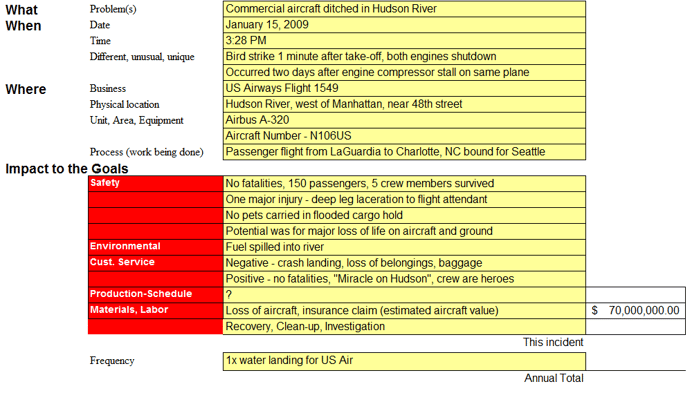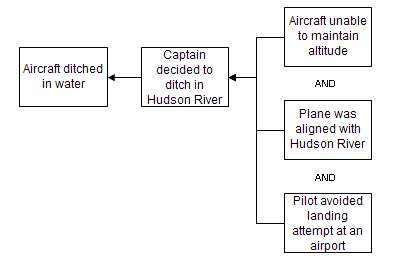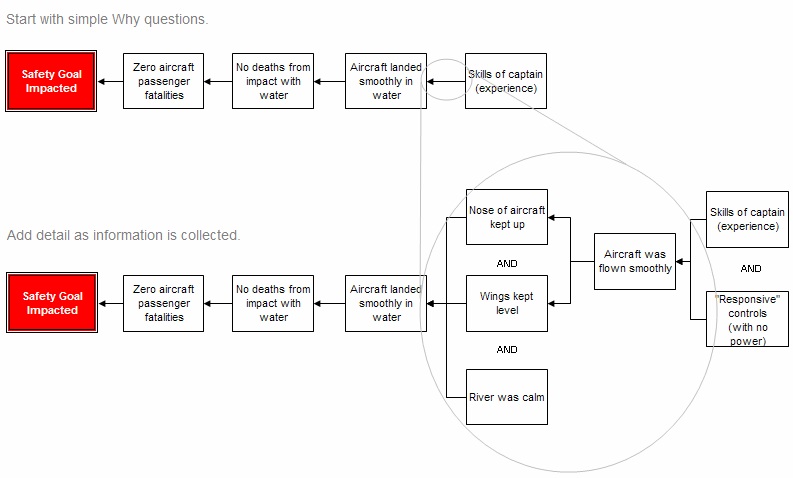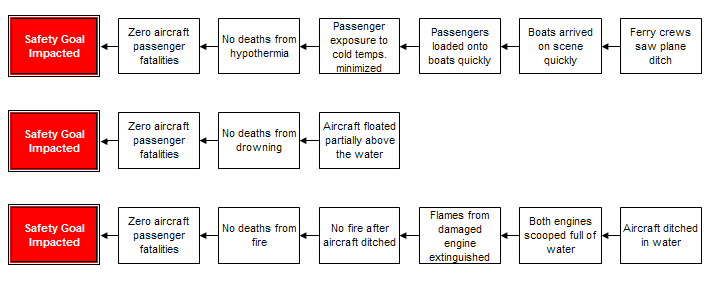Root cause analysis is an approach for identifying the underlying causes of why an incident occurred. The investigation of US Airways Flight 1549 will include both why the aircraft ditched in the river and why all onboard survived. Ordinarily, root cause analysis investigations of plane crashes only address the causes of what went wrong, such as the bird strikes, the loss of the engines and ditching in the river. This root cause analysis for US Airways Flight 1549 will also show what went well regarding the smooth ditching, and the successful evacuation and rescue of all onboard. This root cause analysis, built as a Cause Map, captures all of the causes in a simple, intuitive format.
Summary
On January 15, 2009, US Airways Flight 1549 “ditched” (landed in water) in the Hudson River without losing a single passenger. The most important, and frankly amazing aspect of this incident, is that nobody died. None of the 150 passengers, 3 flight attendants and 2 pilots lost their life due to the crash. There were no fatalities from the crash itself, from hypothermia, or from drowning, which are all certainly possible outcomes for a water landing in New York City in January.
So, although the plane did crash, due to the loss of altitude caused by the loss of both engines (likely due to being simultaneously struck by geese, though this has also not been confirmed), the Captain landed in the river, rather than a populated area. His copilot has said that another consideration in choosing the river was to ensure that passengers would be rescued quickly thanks to the proximity of many ferry boats.
Passengers avoided hypothermia by being rescued quickly, thanks to the quick response of the ferry-boats, whose Captains are trained in water rescue. Passengers were also aided by other passengers, thanks to clear instructions from the crew.
No passengers drowned. The plane was evacuated extremely quickly, thanks to passengers who used their last minutes of air time to review the safety card instructions and the performance of the flight attendants, who are trained to evacuate a plane in 90 seconds. The evacuation was ensured by the Captain and police divers, who checked and double-checked that everyone had made it out safely.
Some causes are linked with AND In between ANDs show where more than one cause is required. When an effect has more than one cause, both causes are placed on the Cause Map. Each cause is connected to the effect with an AND placed in between. These causes are independent of each other, but they are both required to produce that effect. An AND is needed when people provide different, yet valid, explanations of a cause. People think of cause-and-effect as a simple one-to-one relationship; an effect has a cause. In reality, every effect has causes.
Step 1: Define
Step 1 is the Definition of the Problem. It’s written in an outline format so that it’s easy to capture and easy to read. The problem is always defined by the specific impact to the organization’s overall goals (the deviation from the ideal state). In the case of Flight 1549, the impact to safety was a positive. All 155 people on board survived, but it could have been catastrophic. There was also the loss of a $70M aircraft.

Step 2 Analyze
Step 2 is the Analysis of the incident. The cause-and-effect relationships are identified by asking “Why?” questions starting with the Goals that were impacted. While the Cause Map may start linearly, it will expand to provide a detailed view of the entire incident as more information is collected.
Zero Fatalities on the Ground
Question: Why were there no fatalities in the city?
- Because the pilot guided the aircraft clear of populated areas.
- Because the Captain decided to ditch in the Hudson River.
- Because the aircraft was at sufficient altitude (3200 feet).
It’s not a matter of which one is “right.” All of the responses above are accurate cause-and-effect relationships which fit on the Cause Map.

 Question: Why did the captain decide to ditch in the Hudson River?
Question: Why did the captain decide to ditch in the Hudson River?
- Because the aircraft was unable to maintain altitude. This causal path is related to the loss of both engines.
- Because the plane was already aligned with the river. Air traffic control immediately had the pilot turn to the left to return to LaGuardia. This happened to align the aircraft parallel and adjacent to the Hudson River.
- Because the pilot avoided a landing attempt at an airport.
By asking the captain, he can explain the causes of why he decided to ditch in the Hudson. The causes are linked with an AND because they were all required to produce the captain’s decision.
Zero Passenger Fatalities…from Impact with Water
Question: Why was the plane able to land so smoothly in the water?
- Because of the skills of the captain and first officer.
- Because the nose of the aircraft was kept up.
- Because the wings were kept level.
- Because the Hudson River was relatively calm.
These specific details are important if other pilots are going to learn from the incident. Another cause is “the aircraft designers accounted for a scenario where the controls would need to partially function with both engines out.”

Zero Passenger Fatalities…from Hypothermia, Drowning and Fire
Question: Why were there no passenger fatalities on the aircraft?
- Because of how smoothly the aircraft impacted the water.
- Because no one died of hypothermia or drowning.
- Because no one died from fire.
These causes (and more) can be combined onto a Cause Map to accommodate as much detail as needed.

Cause Map – Detailed Level
This Cause Map organizes all of the cause-and-effect relationships from earlier on this page and adds some additional detail. Start with any one of the goals that have been impacted. Read the Cause Map from left to right using the phrase “was caused by” in place of the arrows.
Use horizontal and vertical scroll bars to view to the right and down
Step 3 Prevent
Step 3 is the selection of specific action items to prevent the issue from occurring. The recommendations and action items from the actual Flight 1549 incident will be included once they are made available.
Lessons Learned for your Organization
Following are some specific lessons from Flight 1549. Review them at your next staff or safety meeting. The concepts are applicable within any organization interested in improving their reliability.
“Cross-check and verify”
This incident provides a valuable reminder that little tasks can have a big impact on reliability. When you hear flight attendants say “cross-check and verify,” they are double-checking the exit doors and emergency slides. A girt bar, attached to the exit door, must be manually engaged before takeoff and then disengaged after landing. This ensures the slide will deploy when the door is opened “in the event of an emergency.” Photos from Flight 1549 show passengers climbing onto the floating slides on either side of the forward exits to be picked up by boat. The forward slides on Flight 1549 had been armed and functioned properly when needed.
What are the girt bars in your organization?
Some tasks may seem insignificant, because “nothing ever happens,” but in certain situations, those minor tasks can mean the difference between life and death. The girt bar is moved into and out of position on every single commercial flight. In some organizations, tasks that appear unnecessary may eventually be skipped. In high-risk operations, it’s important to maintain a disciplined approach. Within healthcare, checking the girt bar is analogous to verifying the medication that’s about to be administered to a patient. Within industrial companies, it’s verifying energy sources in a lock-out, tag-out procedure. When someone asks, “Do we really need to do this every time? Nothing has ever happened.” The response in high-reliability organizations is “Yes….every time.” The proper position of the girt bar is a cause of zero passenger fatalities. Find it on the detailed Cause Map to review with your group.
Aircraft lost both engines
One of the causes on the detailed Cause Map is “Aircraft lost both engines.” The engines may have failed due to severe damage caused by the bird strikes. Or, the engines may have been directed to shut down by the onboard computer when it received bogus information from damaged instruments. These are possible causes. They are designated on the Cause Map with a question mark (?) because there’s no evidence…yet. Collecting evidence is a fundamental piece of the National Transportation Safety Board’s investigation. Problem-solving in your organization should also be driven by evidence; not opinion and speculation.
Interestingly, two days before ditching in the Hudson River, the number 2 engine, on this same aircraft, shutdown and had to be restarted in flight. The root cause analysis will reveal details about whether or not the two incidents are related.
Bring Cause Mapping® Root Cause Analysis training to your site
Schedule a workshop at your location to train your team on how to lead, facilitate, and participate in a root cause analysis investigation.
